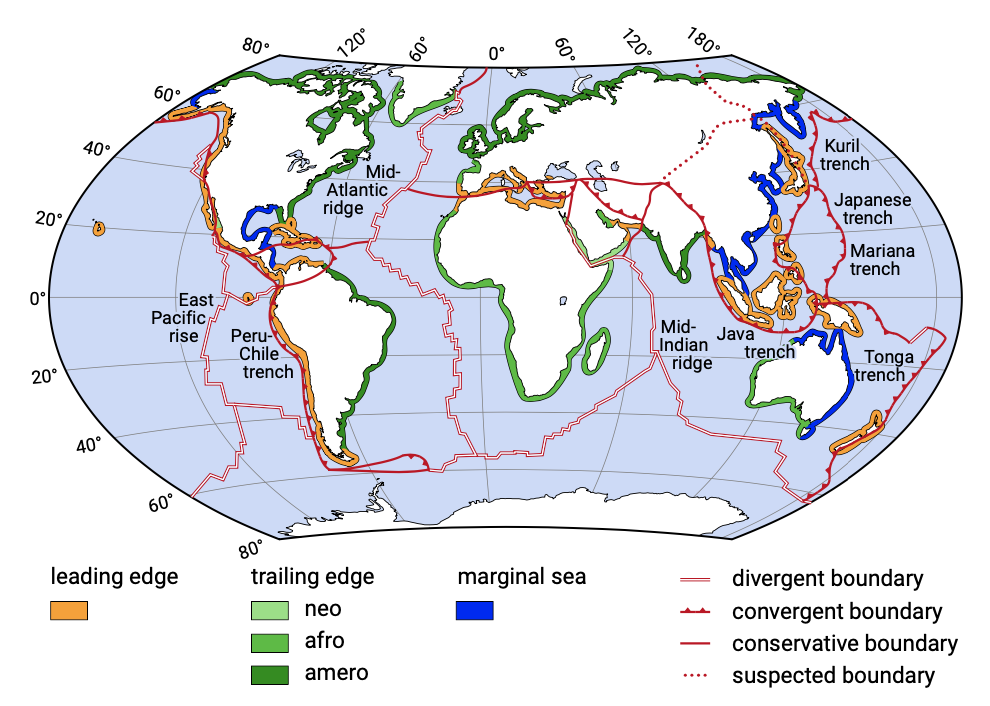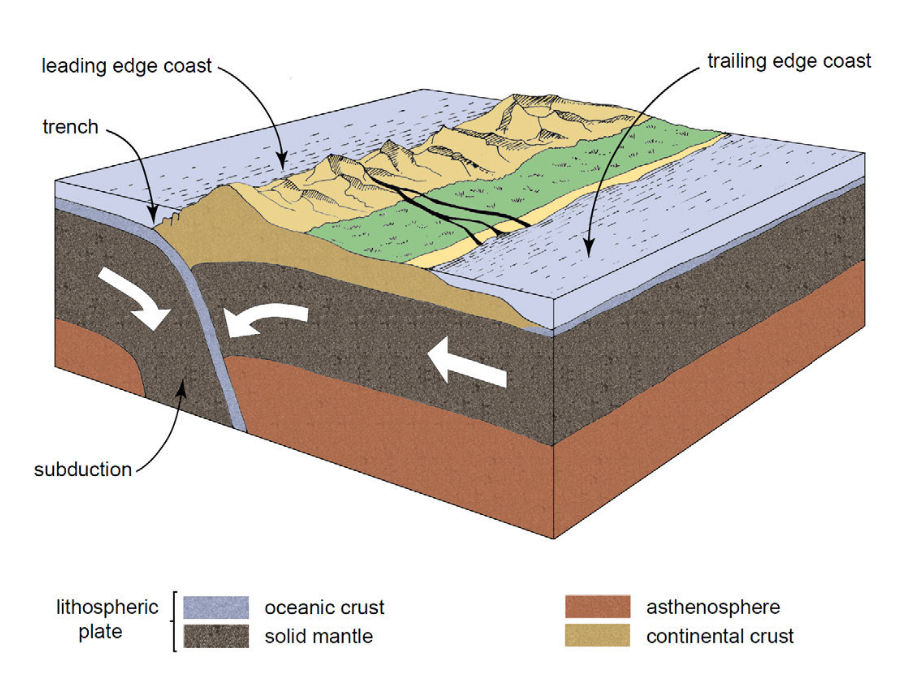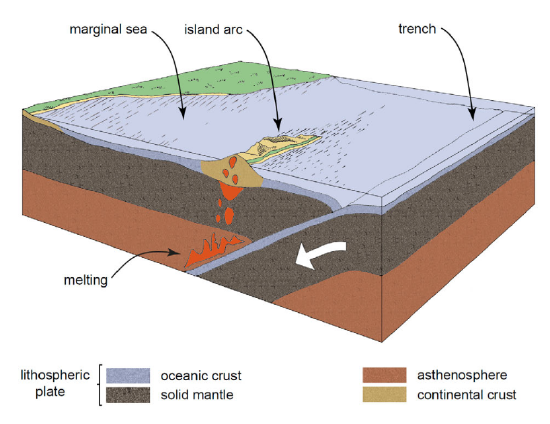2.3.2: Tectonic plate setting of coasts
- Page ID
- 16270
\( \newcommand{\vecs}[1]{\overset { \scriptstyle \rightharpoonup} {\mathbf{#1}} } \)
\( \newcommand{\vecd}[1]{\overset{-\!-\!\rightharpoonup}{\vphantom{a}\smash {#1}}} \)
\( \newcommand{\id}{\mathrm{id}}\) \( \newcommand{\Span}{\mathrm{span}}\)
( \newcommand{\kernel}{\mathrm{null}\,}\) \( \newcommand{\range}{\mathrm{range}\,}\)
\( \newcommand{\RealPart}{\mathrm{Re}}\) \( \newcommand{\ImaginaryPart}{\mathrm{Im}}\)
\( \newcommand{\Argument}{\mathrm{Arg}}\) \( \newcommand{\norm}[1]{\| #1 \|}\)
\( \newcommand{\inner}[2]{\langle #1, #2 \rangle}\)
\( \newcommand{\Span}{\mathrm{span}}\)
\( \newcommand{\id}{\mathrm{id}}\)
\( \newcommand{\Span}{\mathrm{span}}\)
\( \newcommand{\kernel}{\mathrm{null}\,}\)
\( \newcommand{\range}{\mathrm{range}\,}\)
\( \newcommand{\RealPart}{\mathrm{Re}}\)
\( \newcommand{\ImaginaryPart}{\mathrm{Im}}\)
\( \newcommand{\Argument}{\mathrm{Arg}}\)
\( \newcommand{\norm}[1]{\| #1 \|}\)
\( \newcommand{\inner}[2]{\langle #1, #2 \rangle}\)
\( \newcommand{\Span}{\mathrm{span}}\) \( \newcommand{\AA}{\unicode[.8,0]{x212B}}\)
\( \newcommand{\vectorA}[1]{\vec{#1}} % arrow\)
\( \newcommand{\vectorAt}[1]{\vec{\text{#1}}} % arrow\)
\( \newcommand{\vectorB}[1]{\overset { \scriptstyle \rightharpoonup} {\mathbf{#1}} } \)
\( \newcommand{\vectorC}[1]{\textbf{#1}} \)
\( \newcommand{\vectorD}[1]{\overrightarrow{#1}} \)
\( \newcommand{\vectorDt}[1]{\overrightarrow{\text{#1}}} \)
\( \newcommand{\vectE}[1]{\overset{-\!-\!\rightharpoonup}{\vphantom{a}\smash{\mathbf {#1}}}} \)
\( \newcommand{\vecs}[1]{\overset { \scriptstyle \rightharpoonup} {\mathbf{#1}} } \)
\( \newcommand{\vecd}[1]{\overset{-\!-\!\rightharpoonup}{\vphantom{a}\smash {#1}}} \)
\(\newcommand{\avec}{\mathbf a}\) \(\newcommand{\bvec}{\mathbf b}\) \(\newcommand{\cvec}{\mathbf c}\) \(\newcommand{\dvec}{\mathbf d}\) \(\newcommand{\dtil}{\widetilde{\mathbf d}}\) \(\newcommand{\evec}{\mathbf e}\) \(\newcommand{\fvec}{\mathbf f}\) \(\newcommand{\nvec}{\mathbf n}\) \(\newcommand{\pvec}{\mathbf p}\) \(\newcommand{\qvec}{\mathbf q}\) \(\newcommand{\svec}{\mathbf s}\) \(\newcommand{\tvec}{\mathbf t}\) \(\newcommand{\uvec}{\mathbf u}\) \(\newcommand{\vvec}{\mathbf v}\) \(\newcommand{\wvec}{\mathbf w}\) \(\newcommand{\xvec}{\mathbf x}\) \(\newcommand{\yvec}{\mathbf y}\) \(\newcommand{\zvec}{\mathbf z}\) \(\newcommand{\rvec}{\mathbf r}\) \(\newcommand{\mvec}{\mathbf m}\) \(\newcommand{\zerovec}{\mathbf 0}\) \(\newcommand{\onevec}{\mathbf 1}\) \(\newcommand{\real}{\mathbb R}\) \(\newcommand{\twovec}[2]{\left[\begin{array}{r}#1 \\ #2 \end{array}\right]}\) \(\newcommand{\ctwovec}[2]{\left[\begin{array}{c}#1 \\ #2 \end{array}\right]}\) \(\newcommand{\threevec}[3]{\left[\begin{array}{r}#1 \\ #2 \\ #3 \end{array}\right]}\) \(\newcommand{\cthreevec}[3]{\left[\begin{array}{c}#1 \\ #2 \\ #3 \end{array}\right]}\) \(\newcommand{\fourvec}[4]{\left[\begin{array}{r}#1 \\ #2 \\ #3 \\ #4 \end{array}\right]}\) \(\newcommand{\cfourvec}[4]{\left[\begin{array}{c}#1 \\ #2 \\ #3 \\ #4 \end{array}\right]}\) \(\newcommand{\fivevec}[5]{\left[\begin{array}{r}#1 \\ #2 \\ #3 \\ #4 \\ #5 \\ \end{array}\right]}\) \(\newcommand{\cfivevec}[5]{\left[\begin{array}{c}#1 \\ #2 \\ #3 \\ #4 \\ #5 \\ \end{array}\right]}\) \(\newcommand{\mattwo}[4]{\left[\begin{array}{rr}#1 \amp #2 \\ #3 \amp #4 \\ \end{array}\right]}\) \(\newcommand{\laspan}[1]{\text{Span}\{#1\}}\) \(\newcommand{\bcal}{\cal B}\) \(\newcommand{\ccal}{\cal C}\) \(\newcommand{\scal}{\cal S}\) \(\newcommand{\wcal}{\cal W}\) \(\newcommand{\ecal}{\cal E}\) \(\newcommand{\coords}[2]{\left\{#1\right\}_{#2}}\) \(\newcommand{\gray}[1]{\color{gray}{#1}}\) \(\newcommand{\lgray}[1]{\color{lightgray}{#1}}\) \(\newcommand{\rank}{\operatorname{rank}}\) \(\newcommand{\row}{\text{Row}}\) \(\newcommand{\col}{\text{Col}}\) \(\renewcommand{\row}{\text{Row}}\) \(\newcommand{\nul}{\text{Nul}}\) \(\newcommand{\var}{\text{Var}}\) \(\newcommand{\corr}{\text{corr}}\) \(\newcommand{\len}[1]{\left|#1\right|}\) \(\newcommand{\bbar}{\overline{\bvec}}\) \(\newcommand{\bhat}{\widehat{\bvec}}\) \(\newcommand{\bperp}{\bvec^\perp}\) \(\newcommand{\xhat}{\widehat{\xvec}}\) \(\newcommand{\vhat}{\widehat{\vvec}}\) \(\newcommand{\uhat}{\widehat{\uvec}}\) \(\newcommand{\what}{\widehat{\wvec}}\) \(\newcommand{\Sighat}{\widehat{\Sigma}}\) \(\newcommand{\lt}{<}\) \(\newcommand{\gt}{>}\) \(\newcommand{\amp}{&}\) \(\definecolor{fillinmathshade}{gray}{0.9}\)Inman and Nordstrom (1971) recognised that broad coastal characteristics such as shelf width and coastal topography are related to the position on the moving tectonic plates. Not only the proximity of a coast to a plate boundary but also whether this boundary is converging or diverging has a huge influence on the character of that coast. Inman and Nordstrom (1971) classified coasts into three categories according to their tectonic plate setting:
- Leading-edge or collision coasts: associated with the leading-edge of a crustal plate viz. with converging plates. They are characterised by rugged, cliffed coastlines, tectonic activity and a narrow continental shelf;
- Trailing-edge coasts or passive margins: coasts that are located away from plate boundaries and are generally tectonically stable because the continent and ad- joining ocean floor are of the same plate. They have wide continental shelves;
- Marginal sea coasts: tectonically stable coasts protected from the open ocean by island arcs at converging plate boundaries.

Figure 2.6 shows the worldwide distribution of coastal types as classified by Inman. Compare this figure with the tectonic plate setting of Fig. 2.2.


Figure 2.7 illustrates the formation of leading-edge coasts and trailing-edge coasts. It can be thought of as a cross-section of North or South America. Along the west coasts of the American continent, denser oceanic plates descend beneath the continental edge of the North and South American plates (see the plate boundaries in for instance Fig. 2.6). This collision has resulted in narrow shelves, earthquakes, coastal uplift, and the formation of mountains immediately inland from the coast: the Andes Mountains and the North American western mountain ranges. This is illustrated by Fig. 2.8, the Big Sur coast in California, USA. The rising magma may also create volcanic activity. In contrast, the east coasts of the American continent lie within the interior of tectonic plates, and therefore experience little tectonic activity and are either stable or subside rather than being uplifted.
Trailing-edge coasts are the result of plate divergence and are facing a spreading centre. In plate tectonics, the formation of an ocean is a spreading process between two newly formed plates. At first this process results in a rift valley (the African Rift Valley being a recent example). In the next stage, the valley has opened up until seawater enters; a present day example is the Red Sea. The spreading process continues, the ocean becomes wider and forms a mature ocean like the Atlantic. The mature trailing-edge coasts bordering that ocean are far away from the mid-plate spreading centre. This means that all coasts on both sides of the Atlantic Ocean in Europe, Africa, North and South America are trailing-edge coasts. Other examples of trailing-edge coasts are the west Australian coasts. Inman and Nordstrom have categorised the new trailing-edge coasts formed near young spreading centres as neo-trailing-edge coasts. Regarding the more mature trailing-edge coasts further from plate boundaries, they discern Afro-trailing-edge coasts and Amero-trailing-edge coasts based on differences in sediment supplies (see Sect. 2.3.3).

The leading-edge coasts as illustrated in Fig. 2.7 develop along the border of a land mass where the oceanic edge of one plate converges with the continental edge of another plate. They are called continental collision coasts. Other examples are found along the coast of Turkey and Greece. Besides these continental collision coasts, also island arc collision coasts can be discerned. The latter form where two oceanic plates collide, see Fig. 2.9.
The island arc is formed from volcanoes which erupt through the overriding plate as the descending plate melts below it. Japan, the Philippines, the Caribbean island arc and the Aleutian island arc in Alaska are examples of collision coasts located along the margin of an island arc. Other examples of island arc coasts collision coasts are found along the coasts of Borneo, Sumatra and New Guinea.
Marginal sea coasts occur in semi-protected environments including eastern Australia, the Gulf of Mexico and eastern Asian shorelines. The left part of Fig. 2.9 shows a marginal, inland sea enclosed between a land mass and a volcanic island arc at the converging plate boundary. The marginal sea coast fronting the inland sea is therefore protected from the open ocean by the volcanic island arcs (e.g. Korea) where a plate collision is occurring. Although fairly close to the convergence zone, the marginal sea coast is far enough away to be unaffected by convergence tectonics – it behaves like a trailing-edge coast.


